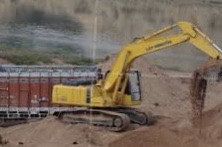
Shades of Grey
Dr Manju Gupta
A recent road trip from my father’s native village in Sagar M.P to my mother’s birthplace Banda U.P. was a bitter sweet experience. I was returning to this sedate region of Bundelkhand after two decades and was greeted by an almost perfect road amid dense teak forests and pristine valleys. Carelessly strewn plastic bags, a sign of modern existence were noticeably absent. I was soaking in the progress, the lush green fields judiciously irrigated by sprinklers when a gust of dust ruined it. As we approached the town of Kabrai we were surrounded by a haze. The decreased visibility was a blessing because what we could see was not a pretty sight. The trees were grey, the land covered with an inch deep layer of dust which rose with each passing vehicle. It was everywhere, on people, their homes, on the food they eat and in the air they breathe.
Stone mining started quite innocuously in this small town of district Mahoba U.P with two stone crusher companies in 1979. The operations grew with government support and now it has become a place for both legal and illegal stone mining. Despite being a socioeconomically important sector, these stone industries reflect blind ambition and have become a curse for local residents. Injudicious quarrying leads to ecological imbalance by way of stone dust emissions that adversely affect the ambient air quality, deplete mountains of the region and render farming lands barren. Continuous mining operations in the form of drilling, blasting, loading, and hauling are all sources of dust emission. When the stone is crushed, a substantial percentage of the dust emissions are carried to the surroundings by wind currents and vehicular movement.
The circulating dust is a source of environmental and health problems which subsequent governments have ignored. The last survey by UP Pollution Control Board was done in 2002. when the particulate matter was said to be 1800 micrograms per cubic metre, much above the permissible limit of 200 micrograms. Mining has increased over the years which suggests that the pollution has worsened. These minute respirable particles of silica lead to silicosis which damages the lungs and causes respiratory problems. Silicosis with tuberculosis or silico-tuberculosis is a leading cause of death in the region. Poverty which is the root cause of malnutrition and biomass burning further predisposes the locals.
Back home, smog has made its appearance and will worsen as the temperature falls. The post Diwali sickening gloom, which engulfed us is still a fresh memory. Broadly speaking air is more toxic in winter because it contains a larger contribution of combustion products. This along with smoke from burning farm residue, fireworks for Diwali, dust from construction sites and vehicle emissions had pushed up levels of tiny suspended particulate matter PM 2.5 and PM 10. Air quality index studies showed that they were hovering over 500 micrograms five times above their safe limit, enough to clog lungs and worsen heart ailments. Widespread rains can help clear this mess but we have to be think twice before praying for rain because when it rains, it pours. The civic authorities may blame it on unprecedented rainfall but the fact stays that there is not a single city in the country which doesn’t come to a grinding halt after a downpour.
The Centre for Science and Environment has reiterated that the recent spell of smog in Delhi was the worst in 17 years. It is a fact that air pollution has steadily increased over decades and stays above safe limits even in the summer months. Still, the contribution of Diwali fireworks in tipping the balance cannot be discounted. This opportunity will be lost if we don’t learn from it and say an emphatic and resounding no to crackers. Why am I harping about this now when the damage has already been done. For the simple reason that Diwali will come again next year and a pledge made while the memory of stinging eyes is still fresh, is more meaningful and easy to remember. Although I agree that saying no to crackers is not enough, it is still a good place to start.
In the evening the nip in the air is missing. It is still pretty warm for this time of the year, a reminder of global warming and melting icecaps. Cases of Dengue and Chikungunya have decreased only to return in greater number next year. This is another fallout of rapid, unplanned urbanisations with inadequate civic amenities. A look at these new debilitating diseases and the sea of suffering humanity makes one wonder about the relevance of the ‘development’ we keep chasing. The gloomy sky, moth eaten mountains, dust covered landscape, inundated land, unusually warm winter and ever evolving diseases are sad reminders of the damage we are doing to our planet.
( published in my column in the Tribune on 17/9/2017)
.
.